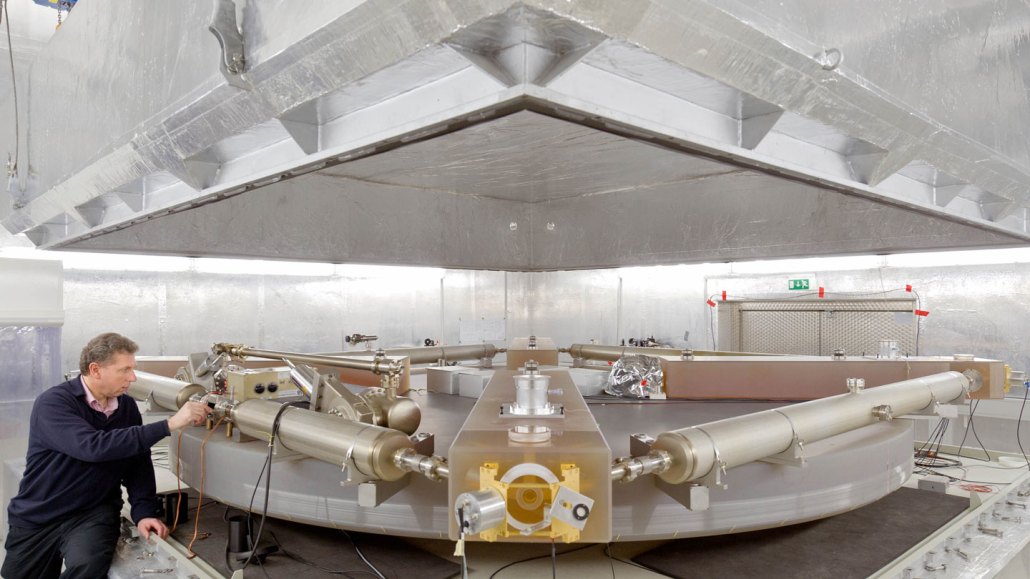A new tool shows tiny changes in the ’24-hour’ length of a day
The laser-gyroscope system can measure day-to-day differences with new precision

The ring laser gyroscope, G, measures tiny changes in Earth’s rotation. It was developed by physicist Ulrich Schreiber (pictured with the gyroscope) and his colleagues.
A. Heddergott/TU Munich
Share this:
- Share via email (Opens in new window) Email
- Click to share on Facebook (Opens in new window) Facebook
- Click to share on X (Opens in new window) X
- Click to share on Pinterest (Opens in new window) Pinterest
- Click to share on Reddit (Opens in new window) Reddit
- Share to Google Classroom (Opens in new window) Google Classroom
- Click to print (Opens in new window) Print
Some days really are longer than others. And now scientists know by just how much.
Earth’s rotation isn’t perfectly steady. Sometimes the planet twirls slightly faster or more slowly. That will make a day shorter or longer — by several milliseconds.
Many of the reasons for Earth’s faster or slower spin are well understood. Take the gravitational pulls of the moon and the sun. These “tidal forces” mess with the planet’s spin by stretching Earth out a tiny bit. Scientists know how to predict those effects on Earth’s rotation. But other factors that affect Earth’s spin are harder to estimate. One example is the churning of air in Earth’s atmosphere or the water in its oceans. Earthquakes can do it, too.
Now, scientists have measured changes in Earth’s rotation by a rate smaller than a millionth of a percent. They used a ring laser gyroscope. The new technique could help scientists understand the complex flows of water and air that cause the tiniest tweaks to our planet’s spin.
Meet G
The gyroscope is known simply as “G.” It’s located at the Geodetic Observatory Wettzell in Germany. And here’s how it works.
Within the gyroscope, laser beams travel around a square-shaped ring. It’s four meters (13 feet) on each side. One laser beam travels around the ring clockwise. Meanwhile, another circles the ring counterclockwise. Since those beams travel in opposite directions, Earth’s rotation affects them differently.
Light is made up of waves. Just like waves in water, light waves can have longer or shorter wavelengths. When the laser light inside G travels in the direction of Earth’s rotation, its light waves get stretched out. The wavelength lengthens because the planet’s turning elongates the path along which these light waves have to travel. But waves of light inside G traveling against the direction of Earth’s spin get squished. That shortens their wavelength.
When combined, these light beams traveling in opposite directions through G create a “beat” signal. You might have heard something similar with sound, which is also made up of waves. Two sound waves with a slightly different pitch will make a beating sound that gets louder and softer, over and over. You can often hear this when two people are playing a note together and one instrument is out of tune.
G’s light makes a similar beat, since its two laser beams have different wavelengths. That beat reveals the rate of Earth’s rotation. This allows G to measure the length of a day to better than a millisecond.
Researchers shared their new results September 18 in Nature Photonics.
Better than ever
Other ways to measure Earth’s rotation rate rely on outside references. For instance, telescopes can use the locations of quasars to measure how much Earth has rotated. (Quasars are the bright cores of active galaxies.) But this method measures Earth’s rotation rate averaged over a whole day. G measures its rotation rate every few hours.
Plus, G’s measurements are made from an underground lab. It doesn’t need to see any part of the outside world to do its job, notes Ulrich Schreiber. He’s a physicist in Germany at the Technical University of Munich who works on G. “A gyroscope measures rotation, absolute,” he says. That is, it measures rotation not relative to some other object — just its own rotation.
Scientists have measured Earth’s spin and tilt with other laser gyroscopes. But they haven’t measured the length of a day to G’s high precision. G is also stable enough to work for months on end. This can reveal changes in Earth’s spin that occur over long timescales.
G’s abilities are unique. “It is a measurement which was considered not possible with other detectors,” says Angela Di Virgilio. This physicist works at the National Institute for Nuclear Physics in Pisa, Italy. She did not take part in the new study. “It is good that they have obtained some results from this impressive instrument,” she says.
Such measurements could help scientists refine their models of Earth’s air circulation and ocean currents.
In the future, scientists hope to measure even more elusive effects on Earth’s spin. Albert Einstein’s general theory of relativity says that a spinning planet should drag spacetime along with it. Ring laser gyroscopes might one day sense such twists and turns of spacetime around Earth. But that would take a tool even more sensitive than G.







